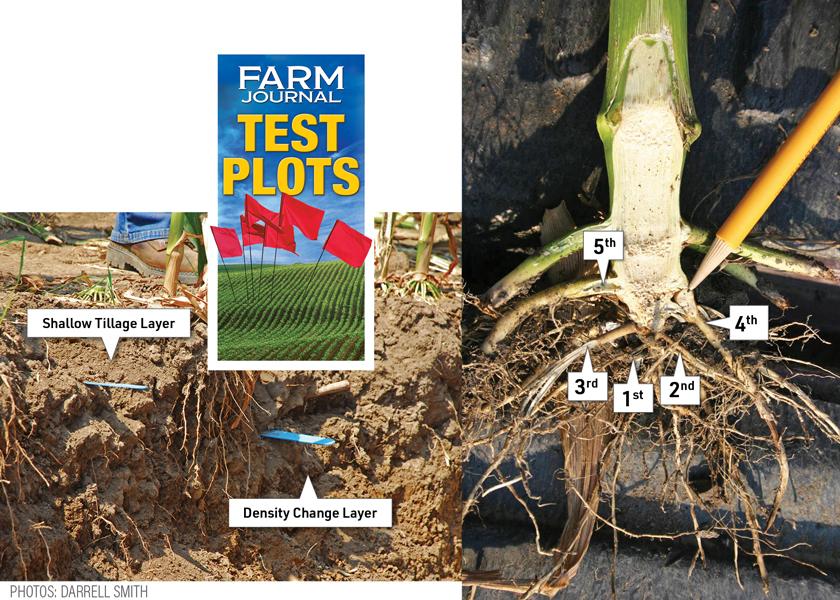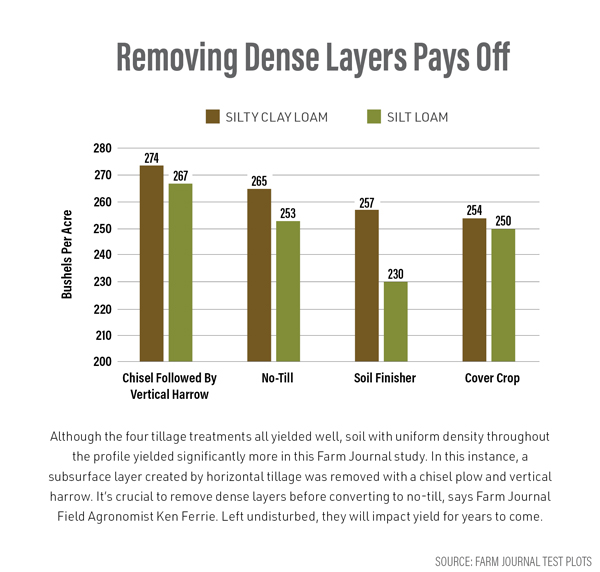How to Combat Soil’s Silent Yield Robbers

Sudden density changes block root growth and water movement
A simple step can create a major yield jump. At least that’s what a Farm Journal Test Plot study revealed. The research shows removing layers before switching to no-till can add 20 bu. to 30 bu. of corn per acre.
To study early soybean planting, Farm Journal Field Agronomist Ken Ferrie was forced to run a soil finisher in wet soil. The previous fall, the field of corn residue had been chisel plowed but not leveled.
“Running that horizontal tillage tool created a soil density layer beneath the surface,” he says. In scientific terms, the bulk density of the tilled soil (the dry weight of soil divided by its volume) was lower than the bulk density of the soil beneath it.
The following season, Ferrie used that field to study the impact of soil density on yield. His crew compared four treatments in strips in the field. They included traditional no-till; no-till with a cover crop (a mixture of seven species); one pass with a field cultivator; and fall chiseling followed by a vertical harrow.
“Through the growing season, we saw visible differences, but only because the strips were side by side,” Ferrie says. “If any of the treatments had covered the entire field, we’d have thought the crop was doing fine. Yields were good — none of the treatments were failures.”
But really, there were substantial differences. In both soil types — silt loam and silty clay loam — chiseling followed by vertical harrowing yielded the most, and one pass with a soil finisher yielded the least.
In silt loam, the difference was 37 bu. per acre; in silty clay loam, it was 17 bu. per acre. The other treatments fell in between.
Soil pits confirmed the density layer put in the previous year was still present in the three treatments that did not include chisel plowing.
“Bio-channels were penetrating the layer and beginning to improve it beneath the cover crop,” Ferrie notes.
FOCUS ON UNIFORMITY
The results confirm Ferrie’s advice to his consulting clients: Use vertical tillage tools to create uniform density throughout the soil profile before converting to no-till planting.
Otherwise, a silent robber might escape with part of your yield.
WHY DENSITY MATTERS
Roots can accommodate gradual changes in soil density, Ferrie explains, but sudden density changes prevent roots from moving deep into soil.
When they hit a layer with higher density (“tighter soil”), they spread out across it rather than penetrating. Layers have the same effect on groundwater trying to move upward and rainwater trying to move downward, so their impact is greatest during wet or dry growing seasons.
Although some density changes occur naturally, with a looser soil lying over a dense soil, most of them are created by horizontal tillage. Because the effect is uniform across entire fields, growers never suspect they are losing yield.
“The shallower the horizontal layer, the more problems it causes,” Ferrie says. “A deep plow sole is less of a problem than a shallow disk layer.”
“In customers’ fields, we often find dense layers that are a decade old,” Ferrie adds. “Freezing and thawing don’t re-move them, as they only float the layers, just as roads float with freeze/thaw cycles.”
MANAGING SOIL DENSITY
No-till and strip-till are great ways to avoid creating sudden density changes that will cause water and root movement problems, according to Ferrie.
“But it’s important to remove existing density layers before switching to one of those systems,” he says. “First, dig down during the growing season to see how roots are performing in your present system and identify layers that are hindering root growth and water movement.”
Layers can be removed by fall tillage, such as chisel plowing, followed by a vertical tillage tool in the spring, done in dry conditions. Shallower layers can be improved with cover crops and with strip-till on less erodible ground.
“The last pass before switching to no-till must not be horizontal tillage,” Ferrie emphasizes. “If you make one or two horizontal passes in the spring without any fall tillage, you will put in a density layer, no matter how patient you are. If you make one of those passes while soil is wet, you’ll also add a compaction layer.”
Your goal, Ferrie summarizes, is gradual density changes through the soil profile, rather than sudden changes which create root- and water-restricting layers. You’ll know you’re there, in the Sustainable Triangle, when soil pits reveal crop roots moving freely downward, at about a 35˚ angle.
“At that point,” he says, “your options are wide open, from no-till to strip-till to cover crops.”
The first, second and third sets of crown roots are very important for yield because they take up a lot of water and nutrients. If those roots are being turned by dense soil layers, yield potential can be reduced.
When roots hit a layer of dense soil, they spread out rather than penetrating deeper. Such layers also restrict water movement upward or downward through the soil profile. Roots should grow freely downward at about a 35˚ angle.
Removing Dense Layers Pays Off
Although the four tillage treatments all yielded well, soil with uniform density throughout the profile yielded significantly more in this Farm Journal study. In this instance, a subsurface layer created by horizontal tillage was removed with a chisel plow and vertical harrow. It’s crucial to remove dense layers before converting to no-till, says Farm Journal Field Agronomist Ken Ferrie. Left undisturbed, they will impact yield for years to come.

Darrell Smith, who’s been with Farm Journal for 40-plus years, works alongside Ken Ferrie to break down the systems approach to farming.







